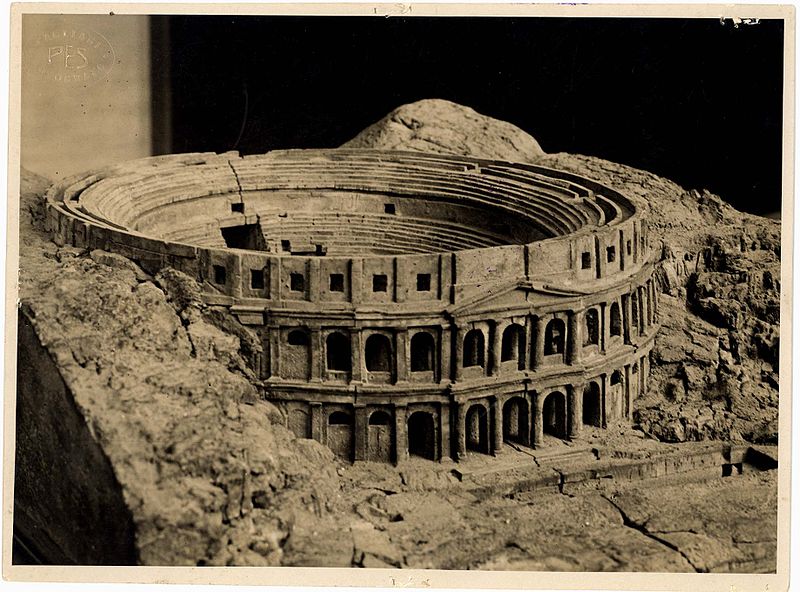SABATO 10 MAGGIO 2014 RIAPRE L’ANFITEATRO ROMANO DI CAGLIARISATURDAY MAY 10,2014 OPEN THE ROMAN ANFITHEATRE IN CAGLIARI
 Sabato 10 maggio 2014 l’Anfiteatro Romano verrà restituito alla città di Cagliari.
Sabato 10 maggio 2014 l’Anfiteatro Romano verrà restituito alla città di Cagliari.
In occasione della prossima edizione di Monumenti Aperti 2014 finalmente anche questo bellissimo anfiteatro sarà visitabile.
Rispetto al recente passato è sparito il palco, è stata smontata anche la platea e le passerelle del primo anello. L’arena dovrà essere dimensionata per un numero massimo di spettatori di 1000/1500.
La storia
Venne edificato tra il I e il II secolo d.C., quando la Sardegna era sottoposta alla dominazione romana.
A seguito della diffusione del cristianesimo nei territori dell’Impero romano, le lotte gladiatorie divennero sempre più impopolari tant’è che nel 438 d.C. l’imperatore Valentiniano III le proibì per legge.
L’anfiteatro cadde così in disuso e a partire dal periodo altomedioevale fino al medioevo venne utilizzato come cava dai vari conquistatori (bizantini, pisani, aragonesi ecc.) che necessitavano di materiali a buon mercato per la costruzione di nuove fortificazioni.
L’anfiteatro oggi
La zona venne acquisita dal comune di Cagliari nel diciannovesimo secolo che affidò gli scavi archeologici al canonico Giovanni Spano. Oggi l’anfiteatro è ricoperto da una struttura in ferro e legno che permette di ospitare spettacoli e concerti durante la stagione estiva. Gli ambientalisti e la sovritendenza archeologica hanno spesso criticato questa struttura (ufficialmente amovibile ma di fatto presente ormai da dieci anni) che ha causato già durante la sua edificazione numerosi danni al monumento e che sta causando, per via della poca circolazione d’aria sotto le tribune, la formazione di muffe le quali stanno lentamente corrodendo la pietra. Anche l’assessore comunale alla cultura Giorgio Pellegrini si è dimostrato critico nei confronti della situazione in cui si trova attualmente l’anfiteatro. Dal 2011 con il cambio dell’amministrazione della città, la nuova giunta guidata dal sindaco Massimo Zedda ha iniziato il graduale procedimento di rimozione delle strutture con l’obiettivo di riportare l’anfiteatro alla sua originaria funzione di sito archeologico.
 Saturday, May 10, 2014 the Roman Amphitheatre will be returned to the city of Cagliari.
Saturday, May 10, 2014 the Roman Amphitheatre will be returned to the city of Cagliari.
On the occasion of the next edition of the Open Monument in 2014 finally this beautiful amphitheater will be open .
Compared to the recent past is gone the stage, the audience was also dismantled and walkways of the first ring . The arena must be dimensioned for a maximum number of viewers of 1000/1500 .
It was built between the first and second centuries AD, when Sardinia was under the Roman rule.
Following the spread of Christianity in the territories of the Roman Empire , gladiatorial fights became increasingly unpopular so much so that in 438 AD Emperor Valentinian III forbade by law.
The amphitheater fell into disuse and so from early medieval period to the Middle Ages it was used as a quarry by the various conquerors ( Byzantines, Pisans , the Aragonese etc.). Needing cheap materials for the construction of new fortifications.
The amphitheater today
The area was acquired by the city of Cagliari in the nineteenth century that gave the archaeological excavations at Canon Giovanni Spano . Today the amphitheater is covered with an iron frame and wood that can accommodate performances and concerts during the summer season. Environmentalists and the archaeological sovritendenza have often criticized this property ( officially removable but in fact this for ten years now ), which has already caused a lot of damage during its construction of the monument and it’s causing, because of the lack of air circulation under the stands, the formation of mold which are slowly eroding the stone. Even the local councilor for culture Giorgio Pellegrini has proven critical of the situation in which it is currently the amphitheater . Since 2011, with the change of administration in the city, the new administration led by Mayor Massimo Zedda began the gradual process of removing the structure with the aim of bringing the amphitheater to its original function of the archaeological site .
Leave a Comment
You must be logged in to post a comment.




